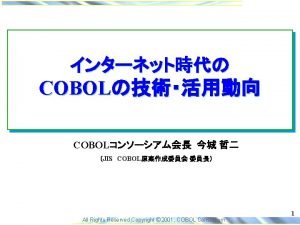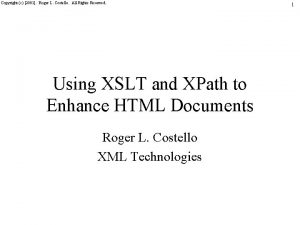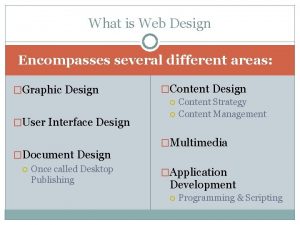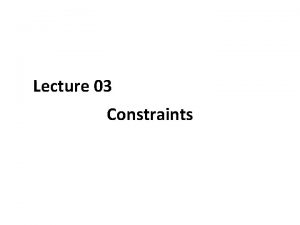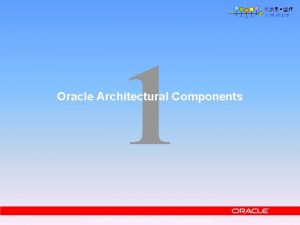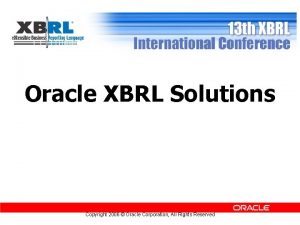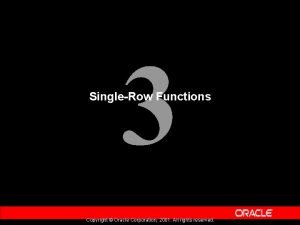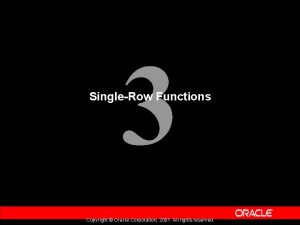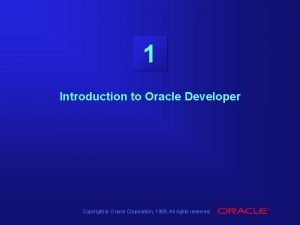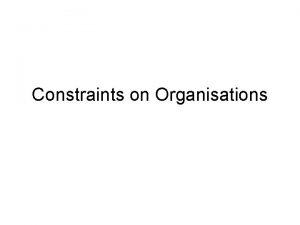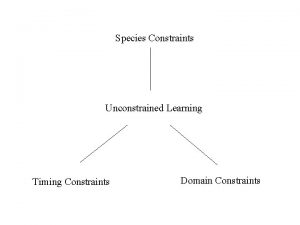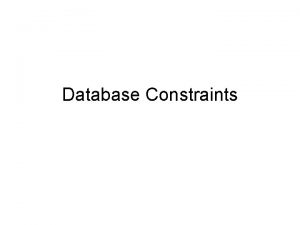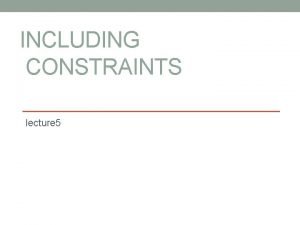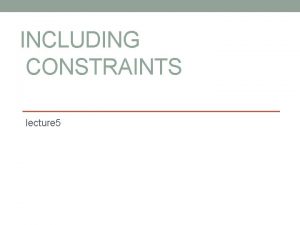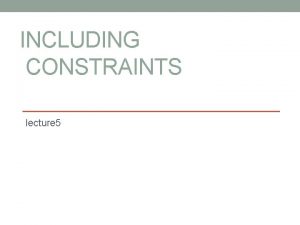10 Including Constraints Copyright Oracle Corporation 2001 All




![Defining Constraints CREATE TABLE [schema. ]table (column datatype [DEFAULT expr] [column_constraint], . . . Defining Constraints CREATE TABLE [schema. ]table (column datatype [DEFAULT expr] [column_constraint], . . .](https://slidetodoc.com/presentation_image_h2/b0f725e40bc2c8996c0c7c3dad6718b9/image-5.jpg)
![Defining Constraints • Column constraint level column [CONSTRAINT constraint_name] constraint_type, • Table constraint level Defining Constraints • Column constraint level column [CONSTRAINT constraint_name] constraint_type, • Table constraint level](https://slidetodoc.com/presentation_image_h2/b0f725e40bc2c8996c0c7c3dad6718b9/image-6.jpg)






















- Slides: 28

10 Including Constraints Copyright © Oracle Corporation, 2001. All rights reserved.

Objectives After completing this lesson, you should be able to do the following: • Describe constraints • 10 -2 Create and maintain constraints Copyright © Oracle Corporation, 2001. All rights reserved.

What Are Constraints? • • Constraints enforce rules at the table level. • The following constraint types are valid: Constraints prevent the deletion of a table if there are dependencies. – NOT NULL – UNIQUE – PRIMARY KEY – FOREIGN KEY – CHECK 10 -3 Copyright © Oracle Corporation, 2001. All rights reserved.

Constraint Guidelines • Name a constraint or the Oracle server generates a name by using the SYS_Cn format. • Create a constraint either: – At the same time as the table is created, or – After the table has been created • • 10 -4 Define a constraint at the column or table level. View a constraint in the data dictionary. Copyright © Oracle Corporation, 2001. All rights reserved.
![Defining Constraints CREATE TABLE schema table column datatype DEFAULT expr columnconstraint Defining Constraints CREATE TABLE [schema. ]table (column datatype [DEFAULT expr] [column_constraint], . . .](https://slidetodoc.com/presentation_image_h2/b0f725e40bc2c8996c0c7c3dad6718b9/image-5.jpg)
Defining Constraints CREATE TABLE [schema. ]table (column datatype [DEFAULT expr] [column_constraint], . . . [table_constraint][, . . . ]); CREATE TABLE employees( employee_id NUMBER(6), first_name VARCHAR 2(20), . . . job_id VARCHAR 2(10) NOT NULL, CONSTRAINT emp_id_pk PRIMARY KEY (EMPLOYEE_ID)); 10 -5 Copyright © Oracle Corporation, 2001. All rights reserved.
![Defining Constraints Column constraint level column CONSTRAINT constraintname constrainttype Table constraint level Defining Constraints • Column constraint level column [CONSTRAINT constraint_name] constraint_type, • Table constraint level](https://slidetodoc.com/presentation_image_h2/b0f725e40bc2c8996c0c7c3dad6718b9/image-6.jpg)
Defining Constraints • Column constraint level column [CONSTRAINT constraint_name] constraint_type, • Table constraint level column, . . . [CONSTRAINT constraint_name] constraint_type (column, . . . ), 10 -6 Copyright © Oracle Corporation, 2001. All rights reserved.

The NOT NULL Constraint Ensures that null values are not permitted for the column: … NOT NULL constraint (No row can contain a null value for this column. ) 10 -7 NOT NULL constraint Absence of NOT NULL constraint (Any row can contain null for this column. ) Copyright © Oracle Corporation, 2001. All rights reserved.

The NOT NULL Constraint Is defined at the column level: CREATE TABLE employees( employee_id NUMBER(6), last_name VARCHAR 2(25) NOT NULL, salary NUMBER(8, 2), commission_pct NUMBER(2, 2), hire_date DATE CONSTRAINT emp_hire_date_nn NOT NULL, . . . 10 -8 Copyright © Oracle Corporation, 2001. All rights reserved. System named User named

The UNIQUE Constraint UNIQUE constraint EMPLOYEES … INSERT INTO Allowed Not allowed: already exists 10 -9 Copyright © Oracle Corporation, 2001. All rights reserved.

The UNIQUE Constraint Defined at either the table level or the column level: CREATE TABLE employees( employee_id NUMBER(6), last_name VARCHAR 2(25) NOT NULL, email VARCHAR 2(25), salary NUMBER(8, 2), commission_pct NUMBER(2, 2), hire_date DATE NOT NULL, . . . CONSTRAINT emp_email_uk UNIQUE(email)); 10 -10 Copyright © Oracle Corporation, 2001. All rights reserved.

The PRIMARY KEY Constraint DEPARTMENTS PRIMARY KEY … Not allowed (Null value) INSERT INTO Not allowed (50 already exists) 10 -11 Copyright © Oracle Corporation, 2001. All rights reserved.

The PRIMARY KEY Constraint Defined at either the table level or the column level: CREATE TABLE departments( department_id NUMBER(4), department_name VARCHAR 2(30) CONSTRAINT dept_name_nn NOT NULL, manager_id NUMBER(6), location_id NUMBER(4), CONSTRAINT dept_id_pk PRIMARY KEY(department_id)); 10 -12 Copyright © Oracle Corporation, 2001. All rights reserved.

The FOREIGN KEY Constraint DEPARTMENTS PRIMARY KEY … EMPLOYEES FOREIGN KEY … INSERT INTO Not allowed (9 does not exist) Allowed 10 -13 Copyright © Oracle Corporation, 2001. All rights reserved.

The FOREIGN KEY Constraint Defined at either the table level or the column level: CREATE TABLE employees( employee_id NUMBER(6), last_name VARCHAR 2(25) NOT NULL, email VARCHAR 2(25), salary NUMBER(8, 2), commission_pct NUMBER(2, 2), hire_date DATE NOT NULL, . . . department_id NUMBER(4), CONSTRAINT emp_dept_fk FOREIGN KEY (department_id) REFERENCES departments(department_id), CONSTRAINT emp_email_uk UNIQUE(email)); 10 -14 Copyright © Oracle Corporation, 2001. All rights reserved.

FOREIGN KEY Constraint Keywords • FOREIGN KEY: Defines the column in the child table at the table constraint level • REFERENCES: Identifies the table and column in the parent table • ON DELETE CASCADE: Deletes the dependent rows in the child table when a row in the parent table is deleted. • ON DELETE SET NULL: Converts dependent foreign key values to null 10 -15 Copyright © Oracle Corporation, 2001. All rights reserved.

The CHECK Constraint • • Defines a condition that each row must satisfy The following expressions are not allowed: – References to CURRVAL, NEXTVAL, LEVEL, and ROWNUM pseudocolumns – Calls to SYSDATE, UID, USER, and USERENV functions – Queries that refer to other values in other rows. . . , salary NUMBER(2) CONSTRAINT emp_salary_min CHECK (salary > 0), . . . 10 -16 Copyright © Oracle Corporation, 2001. All rights reserved.

Adding a Constraint Syntax Use the ALTER TABLE statement to: • Add or drop a constraint, but not modify its structure • • Enable or disable constraints Add a NOT NULL constraint by using the MODIFY clause ALTER TABLE table ADD [CONSTRAINT constraint] type (column); 10 -17 Copyright © Oracle Corporation, 2001. All rights reserved.

Adding a Constraint Add a FOREIGN KEY constraint to the EMPLOYEES table indicating that a manager must already exist as a valid employee in the EMPLOYEES table. ALTER TABLE employees ADD CONSTRAINT emp_manager_fk FOREIGN KEY(manager_id) REFERENCES employees(employee_id); Table altered. 10 -18 Copyright © Oracle Corporation, 2001. All rights reserved.

Dropping a Constraint • Remove the manager constraint from the EMPLOYEES table. ALTER TABLE DROP CONSTRAINT Table altered. • employees emp_manager_fk; Remove the PRIMARY KEY constraint on the DEPARTMENTS table and drop the associated FOREIGN KEY constraint on the EMPLOYEES. DEPARTMENT_ID column. ALTER TABLE departments DROP PRIMARY KEY CASCADE; Table altered. 10 -19 Copyright © Oracle Corporation, 2001. All rights reserved.

Disabling Constraints • • Execute the DISABLE clause of the ALTER TABLE statement to deactivate an integrity constraint. Apply the CASCADE option to disable dependent integrity constraints. ALTER TABLE DISABLE CONSTRAINT Table altered. 10 -20 employees emp_id_pk CASCADE; Copyright © Oracle Corporation, 2001. All rights reserved.

Enabling Constraints • Activate an integrity constraint currently disabled in the table definition by using the ENABLE clause. ALTER TABLE ENABLE CONSTRAINT Table altered. • 10 -21 employees emp_id_pk; A UNIQUE or PRIMARY KEY index is automatically created if you enable a UNIQUE key or PRIMARY KEY constraint. Copyright © Oracle Corporation, 2001. All rights reserved.

Cascading Constraints • The CASCADE CONSTRAINTS clause is used along with the DROP COLUMN clause. • The CASCADE CONSTRAINTS clause drops all referential integrity constraints that refer to the primary and unique keys defined on the dropped columns. The CASCADE CONSTRAINTS clause also drops all multicolumn constraints defined on the dropped columns. • 10 -22 Copyright © Oracle Corporation, 2001. All rights reserved.

Cascading Constraints Example: ALTER TABLE test 1 DROP (pk) CASCADE CONSTRAINTS; Table altered. ALTER TABLE test 1 DROP (pk, fk, col 1) CASCADE CONSTRAINTS; Table altered. 10 -23 Copyright © Oracle Corporation, 2001. All rights reserved.

Viewing Constraints Query the USER_CONSTRAINTS table to view all constraint definitions and names. SELECT FROM WHERE constraint_name, constraint_type, search_condition user_constraints table_name = 'EMPLOYEES'; … 10 -24 Copyright © Oracle Corporation, 2001. All rights reserved.

Viewing the Columns Associated with Constraints View the columns associated with the constraint names in the USER_CONS_COLUMNS view. SELECT FROM WHERE constraint_name, column_name user_cons_columns table_name = 'EMPLOYEES'; … 10 -25 Copyright © Oracle Corporation, 2001. All rights reserved.

Summary In this lesson, you should have learned how to create constraints. • Types of constraints: – NOT NULL – UNIQUE – PRIMARY KEY – FOREIGN KEY – CHECK • 10 -26 You can query the USER_CONSTRAINTS table to view all constraint definitions and names. Copyright © Oracle Corporation, 2001. All rights reserved.

Practice 10 Overview This practice covers the following topics: • • • 10 -27 Adding constraints to existing tables Adding more columns to a table Displaying information in data dictionary views Copyright © Oracle Corporation, 2001. All rights reserved.

10 -30 Copyright © Oracle Corporation, 2001. All rights reserved.
 Copyright 2001
Copyright 2001 Copyright 2001
Copyright 2001 Copyright 2001
Copyright 2001 Copyright (c) 2001
Copyright (c) 2001 Copyright 2001
Copyright 2001 Copyright 2001
Copyright 2001 The mutcd states all workers including emergency responders
The mutcd states all workers including emergency responders The committee (debates/debate) these questions carefully
The committee (debates/debate) these questions carefully Name 3 points
Name 3 points Microsoft corporation. all rights reserved.
Microsoft corporation. all rights reserved. Microsoft corporation. all rights reserved
Microsoft corporation. all rights reserved Microsoft corporation. all rights reserved
Microsoft corporation. all rights reserved Microsoft corporation. all rights reserved
Microsoft corporation. all rights reserved Copyright 2015 all rights reserved
Copyright 2015 all rights reserved Copyright 2015 all rights reserved
Copyright 2015 all rights reserved Dell all rights reserved copyright 2009
Dell all rights reserved copyright 2009 Copyright © 2018 all rights reserved
Copyright © 2018 all rights reserved Printed words including dialogue
Printed words including dialogue It encompasses several different aspects including
It encompasses several different aspects including Ice citation method
Ice citation method Animals including humans year 6
Animals including humans year 6 Animals including humans clipart
Animals including humans clipart Invertebrates including snails slugs and mussels
Invertebrates including snails slugs and mussels Animals including humans year 4
Animals including humans year 4 Printed words including dialogue
Printed words including dialogue How many faces does square pyramid have
How many faces does square pyramid have Including samuel discussion questions
Including samuel discussion questions Invertebrates including snails slugs and mussels
Invertebrates including snails slugs and mussels 2001: űrodüsszeia the sentinel
2001: űrodüsszeia the sentinel
